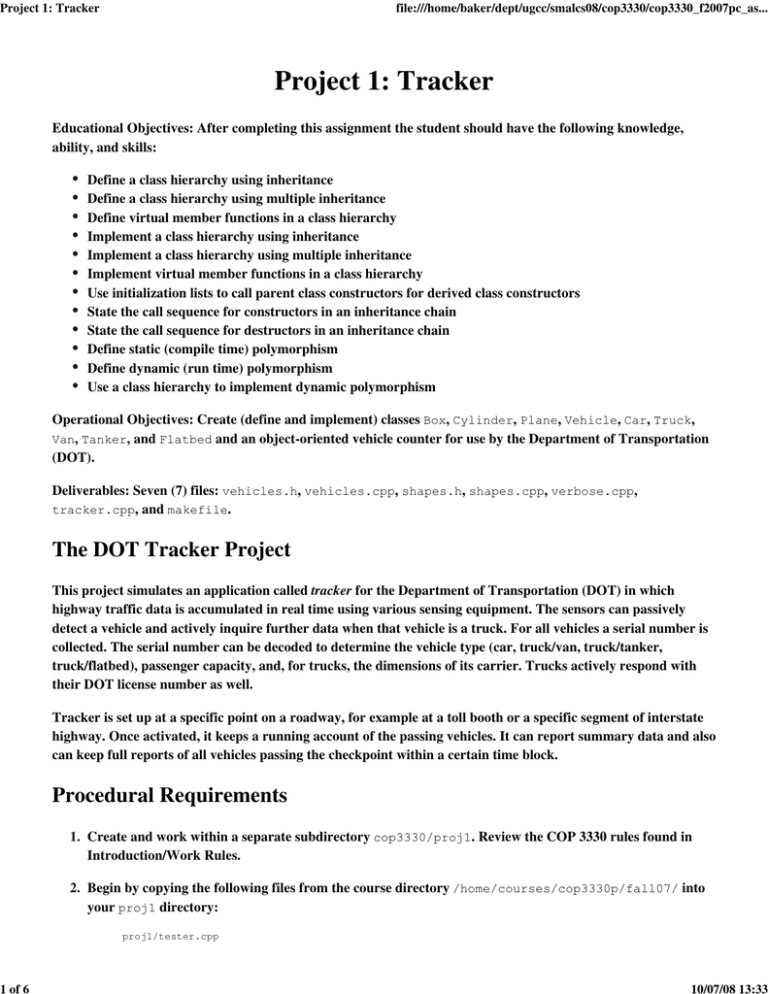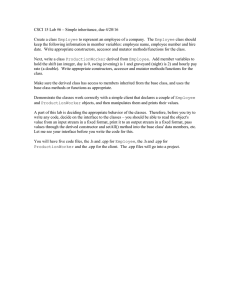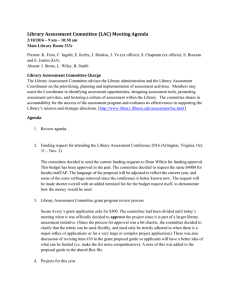Project 1: Tracker
advertisement

Project 1: Tracker 1 of 6 file:///home/baker/dept/ugcc/smalcs08/cop3330/cop3330_f2007pc_as... Project 1: Tracker Educational Objectives: After completing this assignment the student should have the following knowledge, ability, and skills: Define a class hierarchy using inheritance Define a class hierarchy using multiple inheritance Define virtual member functions in a class hierarchy Implement a class hierarchy using inheritance Implement a class hierarchy using multiple inheritance Implement virtual member functions in a class hierarchy Use initialization lists to call parent class constructors for derived class constructors State the call sequence for constructors in an inheritance chain State the call sequence for destructors in an inheritance chain Define static (compile time) polymorphism Define dynamic (run time) polymorphism Use a class hierarchy to implement dynamic polymorphism Operational Objectives: Create (define and implement) classes Box, Cylinder, Plane, Vehicle, Car, Truck, Van, Tanker, and Flatbed and an object-oriented vehicle counter for use by the Department of Transportation (DOT). Deliverables: Seven (7) files: vehicles.h, vehicles.cpp, shapes.h, shapes.cpp, verbose.cpp, tracker.cpp, and makefile. The DOT Tracker Project This project simulates an application called tracker for the Department of Transportation (DOT) in which highway traffic data is accumulated in real time using various sensing equipment. The sensors can passively detect a vehicle and actively inquire further data when that vehicle is a truck. For all vehicles a serial number is collected. The serial number can be decoded to determine the vehicle type (car, truck/van, truck/tanker, truck/flatbed), passenger capacity, and, for trucks, the dimensions of its carrier. Trucks actively respond with their DOT license number as well. Tracker is set up at a specific point on a roadway, for example at a toll booth or a specific segment of interstate highway. Once activated, it keeps a running account of the passing vehicles. It can report summary data and also can keep full reports of all vehicles passing the checkpoint within a certain time block. Procedural Requirements 1. Create and work within a separate subdirectory cop3330/proj1. Review the COP 3330 rules found in Introduction/Work Rules. 2. Begin by copying the following files from the course directory /home/courses/cop3330p/fall07/ into your proj1 directory: proj1/tester.cpp 10/07/08 13:33 Project 1: Tracker 2 of 6 file:///home/baker/dept/ugcc/smalcs08/cop3330/cop3330_f2007pc_as... proj1/segment0.data proj1/segment1.data proj1/segment2.data submitscripts/proj1submit.sh area51/tester_s.x area51/tester_i.x area51/tracker_s.x area51/tracker_i.x The naming of these files uses the convention that _s and _i are compiled from the same cource code on program (Sun/Solaris) and linprog (Intel/Linux), respectively. The executables are distributed only for your information and experimentation. You will not use these files in your own project. 3. You are to define and implement the following classes: Box, Cylinder, Plane, Vehicle, Car, Truck, Van, Tanker, and Flatbed. 4. File shapes.h should contain the definitions of the classes Box, Cylinder, and Plane. File shapes.cpp should contain the member function implementations for these classes. 5. File vehicles.h should contain the definitions of the classes Vehicle, Car, Truck, Van, Tanker, and Flatbed. File vehicles.cpp should contain the implementations for these classes. 6. File verbose.cpp should contain the verbose versions of the various class implementations (both shapes and vehicles). 7. Create a client program for all of these classes in the file tracker.cpp. 8. Create a makefile for all of the project in the file makefile. 9. Turn in all seven (7) files vehicles.h, vehicles.cpp, shapes.h, shapes.cpp, verbose.cpp, tracker.cpp, and makefile using the proj1submit.sh submit script. Warning: Submit scripts do not work on the program and linprog servers. Use shell.cs.fsu.edu to submit projects. If you do not receive the second confirmation with the contents of your project, there has been a malfunction. Code Requirements and Specifications - Server Side 1. You are to define and implement the following classes: Class Name: Box Services (added or changed): float Volume() const // returns volume of box object Private variables: float length_, width_, height_ Class Name: Cylinder Services (added or changed): float Volume() const // returns volume of cylinder object Private variables: float length_, radius_ Class Name: Plane 10/07/08 13:33 Project 1: Tracker 3 of 6 file:///home/baker/dept/ugcc/smalcs08/cop3330/cop3330_f2007pc_as... Services (added or changed): float Area() const // returns area of plane object Private variables: float length_, width_ Class Name: Vehicle Services (added or changed): const char* unsigned int float const char* static VehicleType Private variables: char* serialNumber_; unsigned int passengerCapacity_; SerialNumber PassengerCapacity LoadCapacity ShortName SnDecode () const // returns () const // returns () const // returns () const // returns (const char* sn) Class name: Car Inherits from: Vehicle Services (added or changed): const char* ShortName() const // returns "CAR" Class name: Truck Inherits from: Vehicle Services (added or changed): const char* const char* Private variables: char* DOTLicense_; Class name: Van Inherits from: Truck , Box Services (added or changed): float const char* ShortName DOTLicense LoadCapacity ShortName Class name: Tanker Inherits from: Truck , Cylinder Services (added or changed): float const char* LoadCapacity ShortName Class name: Flatbed Inherits from: Truck , Plane Services (added or changed): float const char* () const () const // returns "TRK" // returns the license no () const () const // returns volume of box // returns "VAN" () const () const LoadCapacity ShortName serial number passenger capacity 0 "UNK" () const () const // returns volume of cylinder // returns "TNK" // returns area of plane // returns "FLT" 2. Each class should have the following: i. Default constructor ii. Parametrized constructor that initializes the class variables iii. Destructor 10/07/08 13:33 Project 1: Tracker 4 of 6 file:///home/baker/dept/ugcc/smalcs08/cop3330/cop3330_f2007pc_as... iv. Private copy constructor prototype v. Private assignment operator prototype vi. Follow the notation conventions: a. Compound names use uppercase letters to separate words likeThis or LikeThis b. Class, method, and function names begin with upper case letters LikeThis c. Object and variable names names begin with lower case letters likeThis d. Class member variables end with underscore likeThis_ 3. Be sure to make exactly the methods virtual that are needed - that is, those that are overridden in derived classes. Do not make a method virtual unless it is needed virtual. 4. During development and testing of the classes, each constructor and destructor should include a line of code that sends an identifying message to standard output. (This requirement serves as a code testing device. These identifying output statements will be removed after development. But leave them in verbose.cpp when you submit!) For example, the Van destructor should output the message "~Van()". 5. The user-defined type VehicleType is an enumerated type: Type name: VehicleType Enumerated values: badSn, vehicle, car, truck, van, tanker, flatbed 6. The static method VehicleType Vehicle::SnDecode(const char* sn) returns the vehicle type based on the first (index 0) character of the serial number sn according to this table: sn[0]: 0 VehicleType: badSn 1 vehicle 2 car 3 truck 4 van 5 tanker 6 flatbed 7. After your classes have been fully developed and tested with tester.cpp: i. Concatenate the files shapes.cpp and vehicles.cpp into the file verbose.cpp ii. Add file documentation to verbose.cpp as usual iii. #include shapes.h and vehicles.h into verbose.cpp, between your file documentation and the beginning of the code iv. Comment out the verbose output statements in the constructors and destructors in shapes.cpp and vehicles.cpp, but leave them in in verbose.cpp v. Make sure that verbose.cpp compiles to object code with our usual compile command vi. We are now ready to proceed to client side development. Code Requirements and Specifications - Client Side 1. You are to implement a client program tracker of the vehicle system described above. 2. Tracker processes data from a file that is input through redirection and sends results to standard output. (Thus tracker does not deal directly with files but reads from and writes to standard I/O.) 3. Tracker goes through the following processing loop: 1. Read the number of vehicles in the next segment 2. If the number is zero, exit 3. For each vehicle in the segment, 10/07/08 13:33 Project 1: Tracker 5 of 6 file:///home/baker/dept/ugcc/smalcs08/cop3330/cop3330_f2007pc_as... 1. Decode the vehicle serial number 2. If other data is needed, read that data 3. Create a vehicle of the appropriate type using the read data 4. After all the vehicles in the segment have been read and their corresponding objects created, for each vehicle in the segment: 1. Report the vehicle data to screen 2. Release the memory used to store the vehicle 4. Note that the tracker processing loop continues until zero is read for a segment size. It may be assumed that the file of data is correctly structured so that whenever an appropriate item is expected, it is next in the file. For all vehicles, the data will begin with the serial number sn and then give the passenger capacity pc. For all specific truck types, the next entry will be the DOTlicense DOTL followed by the dimension data d1 d2 d3(optional). For example, a car, truck, van, tanker, and flatbed would have these lines of data: sn sn sn sn sn pc pc pc pc pc DOTL DOTL d1 d2 d3 DOTL d1 d2 DOTL d1 d2 The dimensional data should be interpreted in the order d1 = length, d2 = width or radius, d3 = height. Note that this is more or less self-documenting in the data file segment0.data 5. Tracker should instantiate the objects of a segment using an array whose elements are of type Vehicle *, that is, pointer to type Vehicle. At the end of reading the segment data, this array should have pointers to vehicle objects representing the entire segment. These objects should exist until the line in the report representing the object is generated. 6. Use declared constants (not hardcoded literal values) for the following: i. The maximum number of vehicles in a traffic segment (100) ii. The maximum number of characters in a vehicle serial number (20) iii. The maximum number of characters in a truck DOT license (20) 7. Check for a segment size greater than tracker can handle, and exit if that happens. Thus tracker would exit if either size 0 is read or some size greater than the declared constant 6.i above. 8. Your tracker.cpp source file should #include <vehicles.h>, but not any of the other project files. Your makefile should create separate object files vehicles.o, shapes.o , and tracker.o and then create the executable tracker.x. 9. Do not submit "verbose" classes for tracker. Hints Model executables tester.x and tracker.x are for your information only - they are not needed for your project. However, tester.cpp is indispensable: This is one of the test programs that will be used to assess your project. Moreover, it will help you debug your classes and gives some example code that can serve as a model for your client tracker program. To execute tester, enter a serial number at the prompt. The first digit determines the vehicle type. Tester uses the verbose implementations, so you should see all of the constructor and destructor calls for the 10/07/08 13:33 Project 1: Tracker 6 of 6 file:///home/baker/dept/ugcc/smalcs08/cop3330/cop3330_f2007pc_as... selected type. To execute tracker on a data file use redirection. For example, enter prompt> tracker.x < segment2.data to run tracker.x with the data file segment2.data as input. All destructors should be declared virtual. Be sure you understand why. There will likely be an exam question related to this. It is wise to develop and test all of the classes prior to working on any code for tracker.cpp. This way you can concentrate on class development - some call this "wearing your server hat". After you are satisfied that your classes are correct and ready for submission, including all documentation etc, only then do you switch to your "client" hat and start working on tracker. If you were starting from "scratch", you would first write a test harness like tester.cpp that exercises your classes and allows you to debug them as a system. The program tester.cpp is central to your effort in several ways: i. It allows you to debug your classes, prior to even thinking about tracker. This way, you are wearing your "server" hat while classes are being created. (One exception: memory management issues may not be exposed by tester.) ii. After the classes are debugged and working correctly, you change to your "client" hat and start working on the tracker program. The file tester.cpp has model code that you should understand in every detail and use as a model for your tracker code. iii. Note: you will likely see code similar to tester on an exam. To compile tester, a command line compile is all that is required, because the source code for the dependent files is included into the client program: prompt> g++ -I. -Wall -Wextra -otester.x tester.cpp Note, this is different from the way you should compile tracker, which requires a makefile to manage separate compilation of all the code files. Your classes will be indepently tested with client programs written to the interfaces defined above. Run the distributed executables for tester and tracker in LIB/area51/ to see how your programs are expected to behave. 10/07/08 13:33




